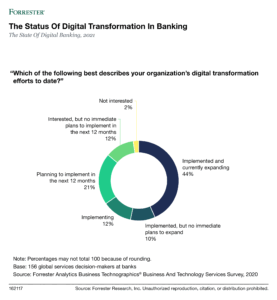In 2021, Banks Must Sustain The Digital Momentum
We’re hitting the end of January. So, let me ask you, how is that New Year’s resolution coming along? Each year, many consumers vow to change their behavior come January 1, resolving to cut down on social media, eat more healthily, sort out their finances, or — for those in lockdown — go for a daily walk or run around the neighborhood. Odds are, they won’t succeed. According to academic studies, it takes on average 66 days to form a new habit. Unfortunately, many will give up on their good intentions after just a few days.
As digital banking executives know all too well, shifting consumer behaviors is no small feat. Whether that’s growing digital adoption or changing financial habits, driving behavioral change requires a good understanding of customers’ needs, customer-centric design and development processes, and tailored marketing and educational tools.
In 2020, though, the COVID-19 pandemic has inarguably fast-tracked the digital shift. From entertainment to shopping, consumers all over the world have tried many digital services and products for the first time. Many consumers have also accessed their financial accounts online via their smartphone, opened a new financial product online, or made digital payments for the first time. As the majority of consumers migrate to digital-first experiences, the “early adopter” or “tech-savvy” profile will apply to the mainstream market. And rather than installing net-new behaviors, the crisis will primarily accelerate preexisting trends.
The pandemic has also driven disruption and turbocharged digital transformation in banking. Banks have never had so much competition. As the COVID-19 crisis further exposed the inefficiencies of current financial services processes, disruptors have been gaining ground, capitalizing on their digital DNA to innovate around retail and business customer needs. Faster, better, and cheaper services, together with new business models, are rapidly altering banks’ competitive landscape. Fintech firms like Solarisbank, Railsbank, and Stripe are offering the modular technology components to help other brands embed financial services into their proposition. Meanwhile, tech titans are also making large strides forward into financial services.

As we researched our new report on The State Of Digital Banking, 2021, we found that a handful of leading banks are pushing ahead with their digital transformation, while many are still struggling to create and execute a coherent transformation strategy:
- Banks’ business priorities have changed as a result of the COVID-19 pandemic. Only 35% of global purchase influencers at banks see accelerating their digital business as a high or critical priority over the next 12 months. Digital transformation is trumped by competing short-term goals and imperatives such as reducing costs, improving ability to innovate, growing revenue, and improving products and services.
- Data issues and security concerns impede banks’ efforts. Among services decision-makers, 25% say that data issues are among the biggest obstacles to digital transformation; 24% cite security.
- Technology strategies and legacy technologies are another big challenge. Many banks’ digital initiatives are held back by their technology strategy and legacy technologies. Ancient core solutions need complex enhancements, lack of skilled and knowledgeable staff causes uncertainty, and fear of failure prevents transformation initiatives even from starting. Reluctant to fully transform their application landscapes, banks easily get stuck in the planning stages or focus their transformation efforts on a single functional or organizational area.
- Operational efficiency and customer experience (CX) are important drivers of digital transformation. As COVID-19 reshapes customer expectations and competition heats up, banks are focusing on improving operational efficiency and CX to better serve customers across all touchpoints.
- Many banks now acknowledge that digital transformation is never-ending. Forty-four percent of global services decision-makers at banks say they’re expanding their transformation.
Many banks have accelerated their digital efforts amid the pandemic. Sustaining that momentum is essential as they enter the recovery phase.
Want to know more? Check out the full report here or request an inquiry call.
